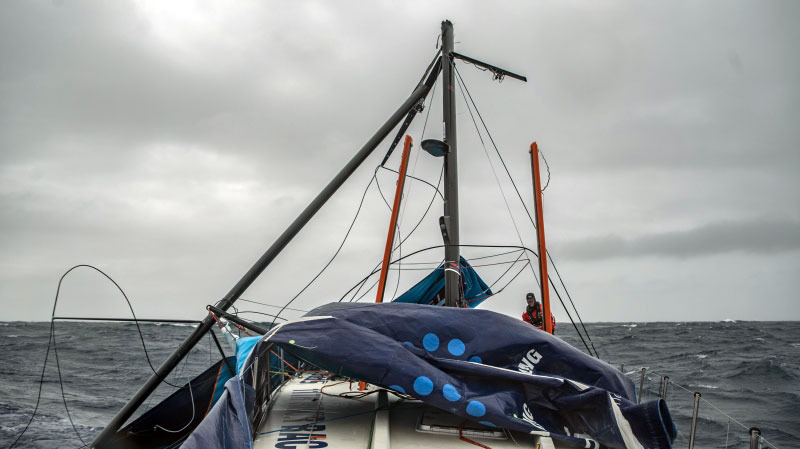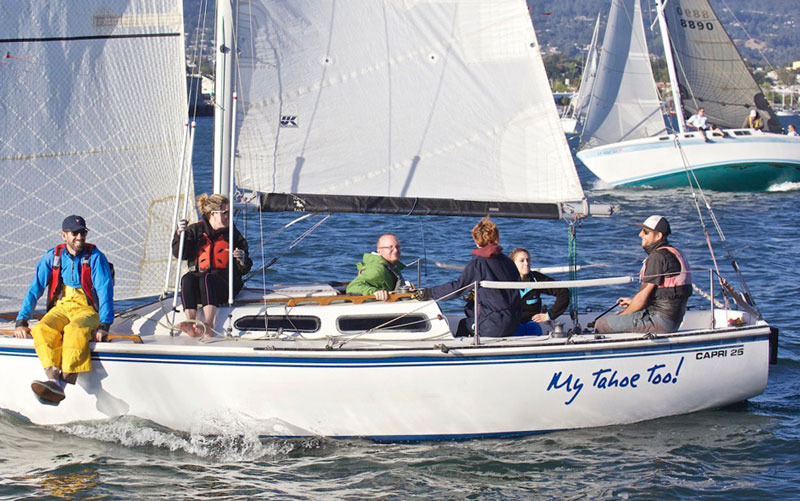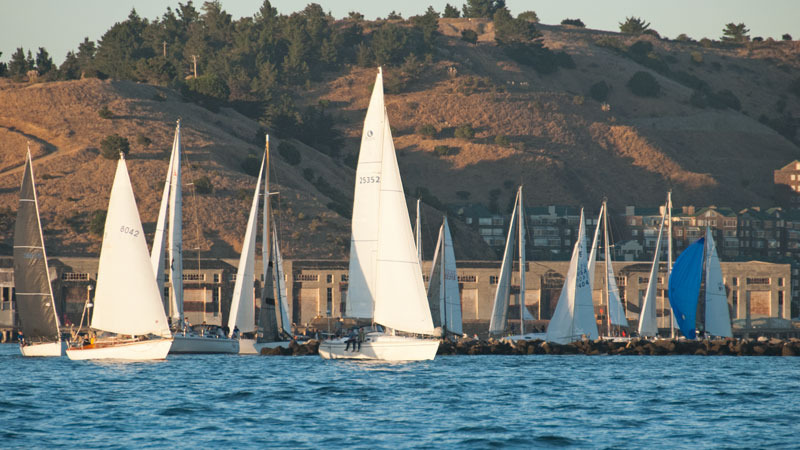
Dismasting in Volvo Ocean Race

Leg 7 of the Volvo Ocean Race has been dramatic on the boats and for sailing fans following along at home. This leg will be most remembered for the tragic loss of Team Scallywag sailor John Fisher, who was knocked overboard in rough conditions during an intense Southern Ocean gale. While that incident has dominated the headlines, every boat has had its fair share of challenges to deal with on an almost daily basis. This has been one of the gnarliest Southern Ocean legs in recent history.

Having rounded Cape Horn in a close back-and-forth battle for second place, Danish/American entry Vestas/11th Hour Racing was putting in an incredible performance in their first leg back from their own tragedy when disaster struck. While sailing on a port-tack close reach in 25-30 knots of breeze and big seas, Vestas’ rig blew up above the first spreaders. The mast came crashing down; the team cut it away to avoid damage to the hull. All crew were reported safe, and the team motored about 100 miles to the Falkland Islands. This was especially heartbreaking for the team, which was chasing valuable points offered on this double-points leg, and looking poised to move back into third place in the rankings.

Behind them, MAPFRE honed their Formula One skills with a perfectly executed pit stop just north of Cape Horn. With mast track damage, boom damage and a mainsail that had torn from leech to luff, the Spanish boat took advantage of the race rules, which are written to allow teams the ability to stop in port and repair their vessel. In doing so, the pit stop must be at least 12 hours in length and the team must sail back through the point where they had previously suspended racing. Tied next to a mega-yacht, the team carried out their repairs and resumed racing after just 13 hours.

Once back in the fleet, MAPFRE benefited from a high-pressure system that slowed down most of the fleet and allowed them to get back in touch with Turn the Tide on Plastic, which was also sailing at reduced speeds to assess and repair damage. Shortly after Vestas’ dismasting, TTOP determined that a fitting that holds the spreaders to the mast had backed out, compromising the rig and preventing them from sailing with full masthead gear or on a starboard tack. With no shortage of ingenuity and heroics from recently injured boat captain Liz Wardley, the team managed to tighten the part in question and resume sailing at full speed.

With all the carnage and chaos that has affected the back half of the fleet, it’s easy to forget that there’s still a close race at the front of the pack, as Dongfeng and Team Brunel are romping into Brazil at more than 20 knots of boatspeed. With around 300 miles to the finish as of this posting, the leading trio (Team Brunel, Dongfeng and AkzoNobel) are being quickly propelled to the finish by strong easterly to southerly winds on the western side of an area of low pressure — surely a welcome respite from the traditional bone-jarring South Atlantic beat to Brazil that is the norm.
Have You Seen This Boat?

Jim Cotton of Santa Rosa sent us this postcard of the 30-ft teak Tahiti ketch Torea. He’s hoping to find her and is even offering a $500 reward for information about her location.
Back in the late 1950s, Jim ran the job to build Torea of teak in the Philippines. The intent was to build a boat that would not dismast if she pitchpoled while rounding Cape Horn. She was launched in 1959, and Jim sailed her from the Philippines "through pirate country," into the Indian Ocean, under Africa, through the Caribbean and Panama to Hawaii. "I got stuck in Hawaii; I’m a surfer," he explained.
After 15 years, Jim sold Torea in Hawaii. She passed through many owners until Jamie White, who rigged Balclutha and Bounty among other tall ships, fell in love with her and rebuilt her. He had a hard time selling the old wooden boat, settling on a $6,000 sale price about five years ago. The new owner lived aboard her in Alameda. Jim got a tour of her, then a couple of years later the boat was gone and the owner would not return his calls.
"I’m very sentimental about the boat," he says. "I’d like to know what became of her. I would like to visit her. Is she in trouble? If the people are sick of her, I might like to buy her."
If you’ve seen Torea or know her whereabouts, please call Jim at (707) 539-1894.
Leeching the Life Away
For those of us with old boats and old sails, you know the sound. You’re sailing along on a decent breeze with the Bay more or less to yourself when it starts. You check the sky around you to see if there’s a helicopter near by, but there isn’t. That incessant humming, that steady vibration that shakes the rig, is coming from your boat — from your jib, to be exact.

This of course is just a symptom of a tired sail. The cloth becomes soft, loses its rigidity, and twists open near the head of the sail, causing the leech to flap and tremble convulsively. Without a leech line, and without adjustable jib leads, there’s nothing to do but watch and listen to the back edge of your sail shudder like mad.
Is there a cheap fix for this problem, one that does not exceed the value of the item in question? Can something be done to remedy an old sail that’s reached this phase? Or is this just a simply a sign that it’s time to stop being so cheap and replace the damn sail? What do you think?
Beer Cans, Extra Light

Not included in last week’s April Racing Preview (because it was already too long) was our region’s Beer Can Series. These evening races, aided and abetted by the advent of Daylight Saving Time, start up anywhere from mid-March to late May depending on location and each club’s inclination. For instance, Santa Cruzers start racing on Wednesday nights as soon as they set their clocks forward an hour the second week in March. At the opposite end of the timeline spectrum, Tahoe YC gets going in late May. In between those extremes, most of the Bay Area series kick off in April.

When Daylight Saving Time rolled around on March 11, the vast majority of our Facebook friends who commented about it were dissing it. But many of those very same friends will be out on the water taking advantage of the extra hour of light on a weeknight, shaking off the workday or workweek, spending time with friends, enjoying the scenery and/or getting their competitive juices flowing in anticipation of more serious weekend racing.

Find a comprehensive listing of Beer Can Series starting on page 20 of the April Latitude 38, or view it online here. As always, our racing editor welcomes snapshots and tales of your Beer Can racing adventures.

©2018Latitude 38 Media, LLC
